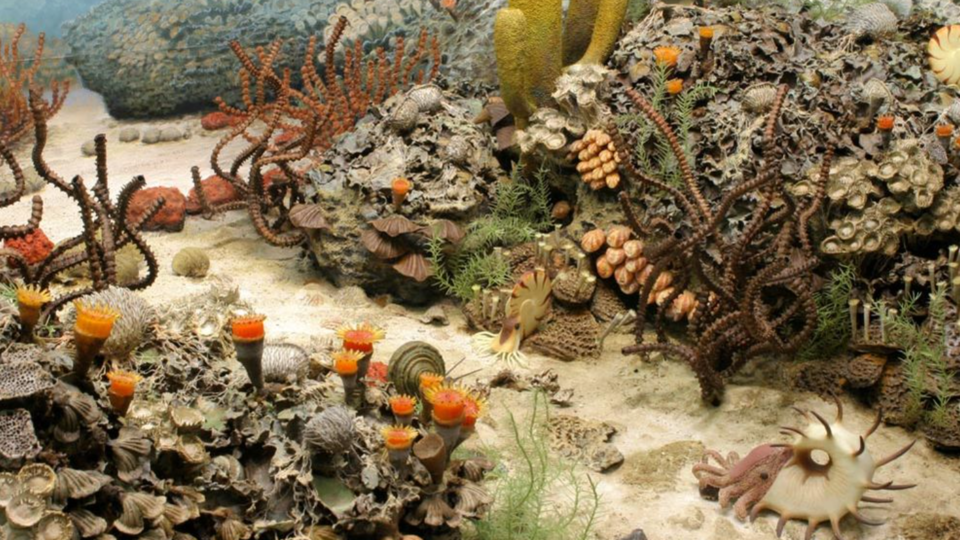Numerous mass extinctions have taken place throughout the Earth’s history, the most noticeable being the Permian-Triassic extinction event, also known as the “Great Dying,” which occurred 252 million years ago. While researchers largely agree on the causes, the exact mechanism by which this mass extinction occurred—and the subsequent ecological collapse—remains a mystery.
 The seafloor during the Permian period prior to the “Great Dying,” the largest mass extinction in Earth’s history. ©University of Michigan Museum of Natural History.
The seafloor during the Permian period prior to the “Great Dying,” the largest mass extinction in Earth’s history. ©University of Michigan Museum of Natural History.
Researchers examined marine ecosystems before, during, and after the “Great Dying” to better comprehend the chain of events that led to ecological destabilization in a study published in Current Biology.
In doing so, the international research team, consisting of scientists from the California Academy of Sciences, the China University of Geosciences (Wuhan), and the University of Bristol, demonstrated that biodiversity loss may be a precursor to a more devastating ecological collapse, a disturbing finding given that the rate of species loss today outpaces that during the “Great Dying.”
The Permian-Triassic extinction serves as a model for studying biodiversity loss on our planet today. In this study, we determined that species loss and ecological collapse occurred in two distinct phases, with the latter taking place about 60,000 years after the initial biodiversity crash.
Peter Roopnarine Ph.D., Academy Curator, Geology, California Academy of Sciences
The event wiped out 95% of life on Earth, or roughly 19 out of every 20 species. It caused climatic conditions like today’s human-caused environmental challenges, such as global warming, ocean acidification, and marine deoxygenation, and was most likely caused by increased volcanic activity and a subsequent spike in atmospheric carbon dioxide.
Researchers examined fossils from South China, a shallow sea during the Permian-Triassic transition, to recreate the ancient marine environment.
The group analyzed prey–predator relationships and ascertained the functions ancient species accomplished by categorizing species into guilds, or groups of species that exploit resources in similar ways. These simulated food webs represented the ecosystem in a plausible way before, during, and after the extinction event.
The fossil sites in China are perfect for this kind of study because we need abundant fossils to reconstruct food webs. The rock sequences can also be dated very precisely, so we can follow a step-by-step timeline to track the extinction process and eventual recovery.
Michael Benton, Professor, University of Bristol
“Despite the loss of over half of Earth’s species in the first phase of the extinction, ecosystems remained relatively stable,” states Academy researcher Yuangeng Huang, Ph.D., now at the China University of Geosciences.
Interactions between species lessened only slightly during the first phase of the extinction, but substantially during the second, causing ecosystems to destabilize. “Ecosystems were pushed to a tipping point from which they could not recover,” Huang adds.
An ecosystem is more resistant to changes in the environment when there are multiple species that perform similar functions. If one species becomes extinct, another can fill the void, and the ecosystem is preserved. This is analogous to an economy in which multiple companies or corporations offer similar services. The downfall of one corporation does not affect the service or the economy, but it does if the service is monopolized by a single entity.
We found that the biodiversity loss in the first phase of the extinction was primarily a loss in this functional redundancy, leaving a sufficient number of species to perform essential functions. But when environmental disturbances like global warming or ocean acidification occurred later on, ecosystems were missing that reinforced resistance, which led to abrupt ecological collapse.
Peter Roopnarine Ph.D., Academy Curator, Geology, California Academy of Sciences
The group’s results underscore the importance of considering functional redundancy when evaluating modern conservation strategies, as well as the pressing need for action to address today’s human-driven biodiversity crisis.
Huang concludes, “We are currently losing species at a faster rate than in any of Earth’s past extinction events. It is probable that we are in the first phase of another, more severe mass extinction. We cannot predict the tipping point that will send ecosystems into total collapse, but it is an inevitable outcome if we do not reverse biodiversity loss.”
Journal Reference:
Huang, Y., et al. (2023) The stability and collapse of marine ecosystems during the Permian-Triassic mass extinction. Current Biology. doi.org/10.1016/j.cub.2023.02.007.